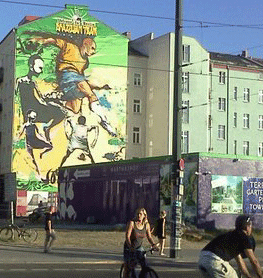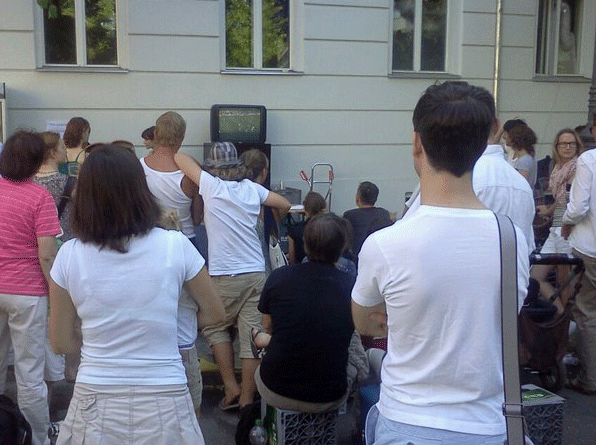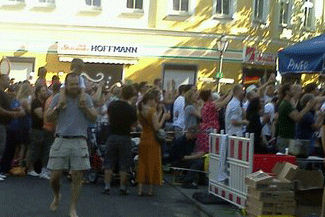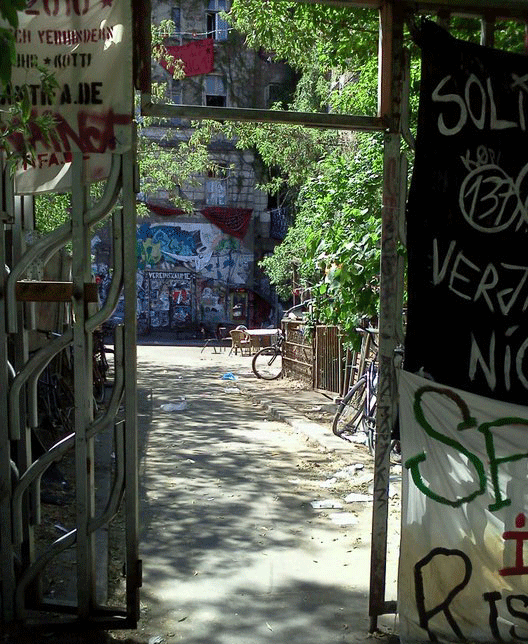More than any other city I’ve been to, Berlin is the closest thing in my mind to what a city “built for the people” looks like.
East Berlin, that is. The ex-West Berlin is completely different, more typical of big western capitals with imposing, super-symmetrical, grey buildings standing starkly next to hyper-modern architecture, big monuments and chain stores strewn about large avenues that take hours to traverse – with many cars on the road and few people on the streets. The whole thing feels a bit cold and impersonal and during working hours, a bit like a giant German ghost town.
The East on the other hand is living. Its chaotic. There is graffiti absolutely everywhere, everywhere everywhere. Paint chips off of buildings, plants grow off ledges of buildings, people whiz by on bikes and smoke in cafes, a constant stream of people occupy the streets: talking, lounging, cooking food, playing football.
The wall might as well still be there – many, in fact would like it to be.
It’s always animated and with no mandatory closing hours for bars and clubs and a subway that never stops, the night literally goes on forever. Days in Berlin flow into one giant never-ending exploration of the city, of conversations with strangers and meetings with friends. My kind of city.

I was recently in Berlin at the same time as the world-cup quarter final qualifying games between Germany and England, a big deal for the country I was visiting, and of course, for my desperate, cringing “Come on mates!” new country of residence.
I started out watching the game in one part of the East and left at half time to meet friends in another part for the second half. By the time I got out of the subway, the game had already started and I was desperate to find a place to catch the rest of the game, friends or no friends. The game was good, the tension palpable as I was now running through the streets looking for a place to watch, 10 minutes into the second half, a solemn German commentator’s voice streaming out of windows. Finally, in the distance off a street on the right, a huge crowd of people stood, blocking all traffic and talking animatedly, occasionally clapping and cheering. I ran towards the crowd to what I was imagining to be a big square with a large screen (typical in European cities for the World Cup) and was happily surprised to find a group of several hundred people huddled around a few small TVs that residents had set on their window sills for all to watch. Couches and armchairs were strewn around the street along with beer crates flipped over and used as chairs, the whole street blocked off and taken over by enthusiastic viewers and children playing in the street. It was fantastic.

 This is a typical scene in Berlin. The first time I went to the city, I walked by an abandoned construction site, in between two tall brick buildings – probably the site of a demolished building – a crane lay idle in the middle and couches were strewn around the field, people tanning, talking in this old furniture, probably recycled from homes, or picked up on the side of roads, a DJ spinning further away in the field. A bar across the road had turned the site into an impromptu lounge for people to enjoy their beers in the sun.
This is a typical scene in Berlin. The first time I went to the city, I walked by an abandoned construction site, in between two tall brick buildings – probably the site of a demolished building – a crane lay idle in the middle and couches were strewn around the field, people tanning, talking in this old furniture, probably recycled from homes, or picked up on the side of roads, a DJ spinning further away in the field. A bar across the road had turned the site into an impromptu lounge for people to enjoy their beers in the sun.
In this sense, Berlin stands in stark opposition to the progressively more restrictive rules on public space, on who has the right to use it and for what it is to be used, which we can witness in most Western cities, and particularly in the States. I’m thinking of Los Angeles or New York City for example, where streets are sanitized and “cleaned up” of everything considered dirty, disorderly or dangerous (youth, punks, homeless people, street musicians, street vendors, etc.) – all the things that makes cities not clean, controlled suburbs that many take refuge in and which is why many city-dwellers including myself love and chose to live in cities in the first place.
These “sanitization” projects are generally accompanied by tightened security measures to prevent people from “loitering” too long or homeless people from hanging around, as well as the construction of new developments and lofts and the implementation of chain stores which out-compete local business, to cater for a new generation of yuppies, businessmen and tourists. (See: Downtown Los Angeles or Hollywood, for example and Villaraigosa’s plans for redeveloping Downtown LA as well as his Safer Cities Initiative, which effectively creates a police zone in an area with a large homeless population largely African American.) In effect we end up with places that look more like “Disneyland” than any real city, places rendered without soul, where people are treated as mindless consumers and where anything unorganized or chaotic is not allowed. Everything has a place and a purpose that the law is around to make sure you follow these rules.
Berlin flips the bird to these evolutions a lot of our cities are taking as well as those contemporary western ideals of what city-centres and public spaces should look like, and perhaps can allow for a conversation on what we, as people, not as corporations or politicians, want our cities to look like, how we want to live and work and use our public space.
Berlin is important to remind us that we still own the streets and that we must reclaim our space as individuals in other spaces. Cities are about people, about exchange, about human expression and confrontation. Here’s to cities which allow for creativity and improvisation. The best part of cities is after all is their disorder.



Celine,
I’m with you in your love for “East” Berlin. However; don’t be so hard on the “West”. It still has Kreuzberg, the better part of Schoeneberg, Marheinekeplatz , Savignyplatz etc. Also, there was far more paint poured on houses in the “East” than the “West” in the last years.
Greetings from LA.
Georg
You’re right! Those are great areas. I suppose I’d just associated them with the “East” in my head because they can be included in this idea of a “resistant city”. Perhaps I shouldn’t have emphasized the difference between East and West so much!
Thanks for your comment Georg!